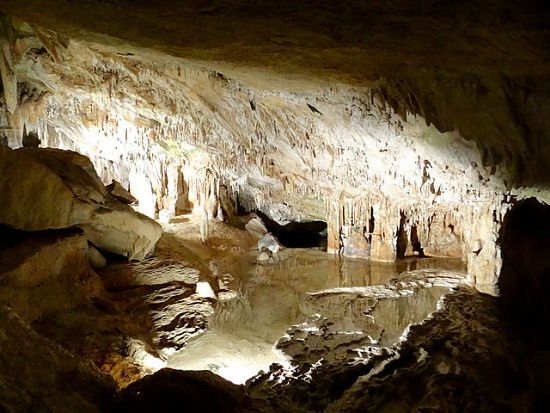
The best caves in Ibiza
- entradilla: Who said that Ibiza was only special because of its beaches? There is a different island through its underground world. From Aquabus we want to tell you about the most popular:
Who said that Ibiza was only special because of its beaches? There is a different island through its underground world. From Aquabus we want to tell you about the most popular:
Cave of San Miguel or Cova de Can Marçà
It is one of the most unknown corners of Ibiza, but one of its great wonders. They are located in a natural enclave north of the island, in Sant Joan de Labritja, specifically in the town of Sant Miquel de Balansat. The cave of Can Marçà is a deposit of more than 100.00 years old, and from it, you can admire the Port of Sant Miquel, the Murada and Ferradura islands and the Torre d’es Mular. The cave, approximately 14 meters high, has been formed by telluric faults. Experts confirm that it has surpassed several meteorological phenomena, such as glaciations and extreme temperatures, which have made it practically fossilized today, full of stalactites and stalagmites, finding water drips in specific areas. Certain beliefs speak that their discovery was thanks to pirates who took advantage of this site as a hiding place for their merchandise, being able to find signs and marks of their passage there today.
The visits to Can Marcà are from May 1 to October 31, from 10:30 a.m. to 8:00 p.m. The price per adult is approximately 10 euros, and for children, 6 euros. In the tour through the interior of the cave, lasting 40 minutes, visitors will enjoy a natural scenery watching the incredible spectacle of water, light and sound underground. Even if you do not want to visit the cave, you will be able to appreciate the spectacular cliffs of the Ibicenco littoral where it is located, which deserve a lot.
These caves are only 20 km from the center of Ibiza, 25 from San Antonio and 23 from Santa Eulalia, three areas of the island near which are ports where the Aquabus ferries dock. The ease offered by our ferries is the great option of We offer departures from the different geographical points of Ibiza: Portinatx, San Antonio, Mar Amantis, Pinet Playa, Punta Xinxó and Port des Torrent. The tour includes a tour guide and transfer by minibus to the place. The trip on the ship lasts a total of five hours that will allow you to nourish yourself with the maritime nature of Pitiusa and the Mediterranean breeze.
Na Coloms or cave of light
Na Coloms is located in the northern part of the island and is a water cave difficult to access, conceived as one of the most secret and inaccessible places on the island and becoming a point of interest tremendously beautiful and striking. The most experienced divers have baptized it as Cueva de la Luz, the name given to it by the rays of sunlight that penetrate through the aquatic gallery illuminating this natural paradise from top to bottom. The cave, in the shape of an inverted cup, only leaves room for more experienced divers, since once in the water, you can only exit through the same place of entry.
Cova des Culleram
It is located on the winding road between Sant Joan de Labritja and the rugged landscape of Cala de San Vicent, 150 meters below sea level and hidden between mountains and forests. It is a particular enclave of Pitiusan archeology: the Punic sanctuary of the cave of Es Culleram is dedicated to Tanit, the main Carthaginian goddess linked to fertility and fortune, among other attributes.
This cave was discovered in 1907 and is approximately 150 meters high. It served as a domestic refuge in prehistoric times, but the Punic, however, made it an important place of worship in Ibiza, between the 5th and 2nd centuries BC. The temple received large groups of priests, who traveled there in times of rituals. As for the sanctuary, it seemed to be divided into three spaces, among which were an open-air courtyard with an altar, where sacrifices and burning of animals were celebrated; the central part that housed the goddess; and a third, the deepest part of the cave. The cave remains open to visitors from Tuesday to Sunday from 10 am to 2 pm from April to October. This visit will allow you to discover the most recondite and spiritual Ibiza.
Cala Llonga Cave or the Cathedral of the Sea
The Cala Llonga Cave is located about 28 meters deep, under a beautiful viewpoint. Cala Llonga gives intense turquoise tones in its waters. The cave has a vault of approximately 15 meters high, in which fantastic plays of lights take place. The exit of this cave surprises us because it twists between the rocks, revealing an impressive wall covered by branches of red coral.
Cova Santa
Discovered in the 15th century and opened to the public in 1957, it is one of the main tourist attractions in Ibiza. Its access is a fissure that opens up in the mountain, giving rise to a grotto that leads to a space that is more than 25 meters deep. Currently it is a landscape of stalactites and stalagmites that is used as a venue for shows and gastronomy.
Ses Fontanelles or Sa Cova des Vi
The cave Ses Fontanelles is the name of a rocky shelter on a cliff located on the south side of Puig Nonó, a Cape of Ibiza that is north of Sant Antoni de Portmany. Ses Fontanelles is right at the foot of Es Cap Nonó, a huge mountain of great verticality on the west coast of the island of Ibiza, being the perfect claim for climbing activities. The main tourist interest of the Ses Fontanelles cave are the cave paintings that are found in the interior, the only ones in the whole island of Pitiusa.
- Hits: 563




